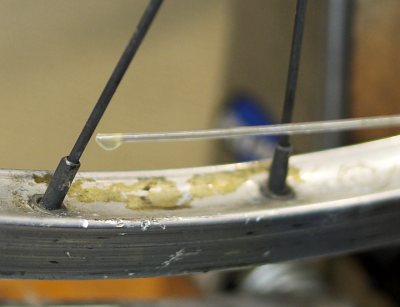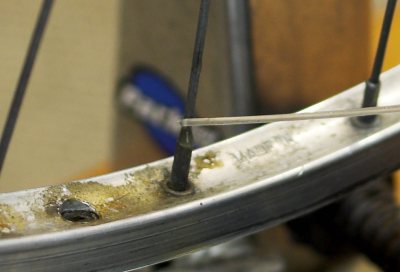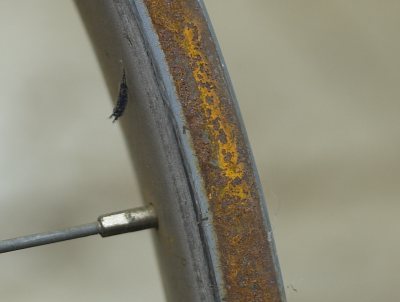To contribute to this wiki, please contact bikebikeeverywhere@gmail.com if you would like us to create you an account. The Contribute to this Wiki page goes into detail about how to make contributions and what information should be included.
Para contribuir a este wiki, por favor escribe a bikebikeeverywhere@gmail.com si deseas que creemos una cuenta para ti. La página Contribute to this Wiki explica en detalle cómo hacer contribuciones y qué información debe incluirse.
Wheel Care
We often have wheels at the co-op that don't belong to bikes - either they came to us as wheels or the bike they were on was ruined. These wheels often need truing or other work before being put back on the bike. However, before a wheel can be trued and prepared to be used on a bike, it needs to be clean and oiled. Even if it doesn't need truing, a wheel should properly cared for before putting it back into use.
There are two jobs to do to keep a wheel running well: cleaning the braking surface, and oiling the nipples. It's also a fine idea to clean the rest of the wheel to make it look a little nicer and keep the people who work with it in the future from getting their hands dirty.
Oiling the nipples consists of putting one drop of oil just above each nipple on the spoke and letting it run down. You'll need to do each one once, and it's a good idea to start at the valve so that you know where to stop. The most important thing to remember is to not over-oil - one drop is all you need, and any more will run all over and you will have to clean it up.
Don't forget to shake the lube.

The easy way to get it right is to let a drop form on the lube straw and then touch it to the spoke, like in these pictures:


Cleaning the braking surface is a different task on aluminum and steel wheels. If the wheel you are cleaning is aluminum, you will be trying to clean off any brake pad rubber or dirt that has attached itself to the rim. Use alcohol and a fairly clean rag.
If the wheel is steel, as long as the chrome plating is there, these won't really stick. The only cleaning you might have to do on a steel wheel is scraping rust, which makes brakes too "sticky" - they grab and don't work right.
You can remove this rust with sandpaper; you will need to take enough off that it's no longer red, and feels fairly smooth.
Once the braking surface is clean and the nipples are lubed, the wheel is ready to be trued or put on a bike - you can put a paper tag on it saying what you did and move on to the next!
